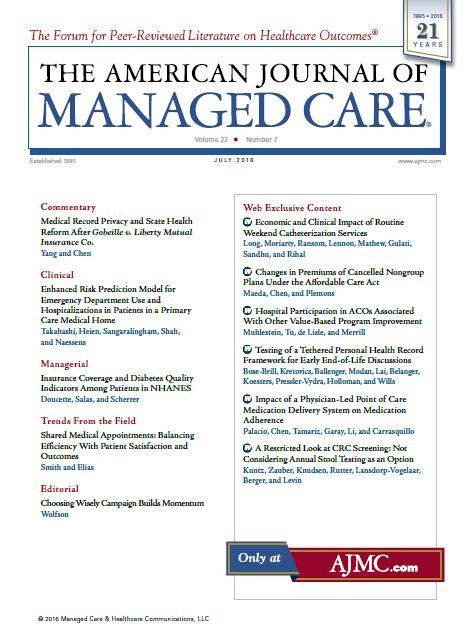- Center on Health Equity & Access
- Clinical
- Health Care Cost
- Health Care Delivery
- Insurance
- Policy
- Technology
- Value-Based Care
Hospital Participation in ACOs Associated With Other Value-Based Program Improvement
Publication
Article
The American Journal of Managed CareJuly 2016
Volume 22
Issue 7
Analyzes whether hospital participation in accountable care organizations is associated with a hospital’s quality and cost improvement outcomes in other Medicare value-based payment programs.
Articles in this issue

Medical Record Privacy and State Health Reform After Gobeille v. Liberty Mutual Insurance Co.
Enhanced Risk Prediction Model for Emergency Department Use and Hospitalizations in Patients in a Primary Care Medical Home
Shared Medical Appointments: Balancing Efficiency With Patient Satisfaction and Outcomes
Insurance Coverage and Diabetes Quality Indicators Among Patients in NHANES
Choosing Wisely Campaign Builds Momentum
A Restricted Look at CRC Screening: Not Considering Annual Stool Testing as an Option
Impact of a Physician-Led Point of Care Medication Delivery System on Medication Adherence
Testing of a Tethered Personal Health Record Framework for Early End-of-Life Discussions
Hospital Participation in ACOs Associated With Other Value-Based Program Improvement
Economic and Clinical Impact of Routine Weekend Catheterization Services
Changes in Premiums of Cancelled Nongroup Plans Under the Affordable Care Act
Related Content
Trends in Hospital Pricing for Vulnerable Emergency Department Users, 2021-2023
December 4th 2025Article
Self-pay emergency department prices rose significantly from 2021 to 2023, especially at for-profit and system-affiliated hospitals, highlighting growing affordability challenges for uninsured and underinsured patients.
Read More
